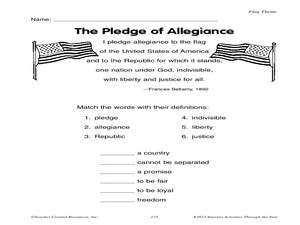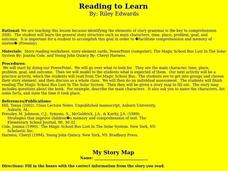Curated OER
Introduce: Comprehension Strategy: Comprehension Monitoring
Help readers develop awareness of comprehension issues and employ tools for better understanding. The best way to begin this strategy is to model it through a think aloud. Choose a book scholars will also be reading, preferably one they...
Scholastic
Selecting Favorite Poems From Historical Poets
Here is a poetry lesson that begins with a free-association activity focused on the word voice. Learners each sit alone for a moment and make sounds that express how they are currently feeling, and then turn to their partners to share...
Curated OER
Pink and Say
Read Pink and Say and discuss the Civil War with your upper elementary learners. They create a KWL about the Civil War and record words relating to the Civil War as they read the book. Then they work in groups to create an ABC...
Curated OER
Call It a Hunch
Give young scholars a chance to practice making inferences after reading the book Through My Eyes by Ruby Bridges. They confirm whether or not their conclusions are true, have a class discussion, and then independently complete an...
Curated OER
Developing a Central Idea in Narrative Writing
At the beginning of the lesson, the class discusses the central idea of a poem. After that, the teacher reads a poem, embedded in the plan, to the class. In groups of two or three, learners create their own poem in response to the...
Curated OER
Foreshadowing and Prediction: W.W. Jacob's, "The Monkey's Paw"
W.W. Jacobs' story "The Monkey's Paw" provides plenty of foreshadowing which readers use to make predictions in this tightly composed, sound instructional plan. Your class reads the story, recording predictions and checking for veracity...
Curated OER
The Legend of Sleepy Hollow
Explore Washington Irving's "The Legend of Sleepy Hollow" in this literature analysis lesson. Middle schoolers read and summarize the plot of the story. They then adapt passages for a contemporary audience and analyze the...
Prestwick House
Teaching Shakespeare: Sonnet 73
It's that time of year to consider how Shakespeare selects his images and structures his Sonnet 73 to develop the meaning of the poem. Class members examine the rhyme scheme, the indented lines, the conceit, and the images used in each...
Curated OER
What is a Fable?
Students read a variety of electronic Aesop's fables to define fable and moral, and write and illustrate an original fable. They then publish their fable using PowerPoint.
Curated OER
Ain't Gonna Rain No More
In this creative writing lesson, pupils listen to the song "It Ain't Gonna Rain No More", read the book adaptation titled I Ain't Gonna Paint No More!, and pay close attention to the rhyming scheme, punctuation and illustrations. ...
Curated OER
Poetry - Landscape, Comparison, and Critical Response
Students compare and evaluate landscape poetry. In this poetry lesson plan, students read poetry by Owen Sheers that describes place/landscapes. They read and compare two similar poems before looking at visual images related to the...
Curated OER
The Big Green Monster
Students practice rereading selected passages to improve their reading fluency. Working in pairs, students read and reread decodable, leveled passages. They complete center activities in groups of four in order to aid in decoding and...
Curated OER
Parental Responsibilities
Pupils discuss their responsibilities and experiences as parents. Individually, students create a list of parental responsibilities. Individual lists are combined and discussed with the whole class. This lesson is designed for pupils...
Curated OER
The Boy Who Cried Wolf
Second graders listen to the story, THE BOY WHO CRIED WOLF and in pairs, discuss the theme of the book and two things that they liked about it. They then read the book OOPS and discuss the theme of the book identifying the things they...
Curated OER
What If?
Second graders read WHAT IF? up to the page that ends "Suddenly, across the field they saw..." and discuss how the animals are feeling. They then discuss their feelings and in pairs discuss a possible ending to the story.
Curated OER
Puss in Boots/Jamil and the Clever Cat
Second graders read the story PUSS IN BOOTS identifying main characters, setting, and significant events. They then read the story JAMIL AND THE CLEVER CAT and compare it with the story PUSS IN BOOTS compiling a list of characters,...
Curated OER
A Plump and Perky Turkey
Help readers recognize elements in a story. They will use pictures and text to gain meaning from written material. Have learners listen to the story A Plump and Perky Turkey and participate in a discussion. They recognize the...
Curated OER
Cloze Instruction And Herringbone Technique
Students sort out important information and create a visual framework for reviewing in the future. They organize a large quantity of information thus helping with learning and remembering details, cause and effect, comparison and...
Curated OER
Flag Language Arts
Students write a description of a flag. In this writing instructional activity, students pick a flag and write a description of it. Students should include colors and symbols present on the flag. Students share their descriptions and the...
Curated OER
Johnny Appleseed Reading and Writing
First graders explore language arts by reading a classic story in class. In this word choice lesson, 1st graders read the story of Johnny Appleseed and identify the descriptive words and sentences the author used to entice the reader....
Curated OER
Language Arts: Creating Character Maps
Third graders select characters from books they have read to create character maps. After drawing the maps, they add the characteristics around a sketch of their chosen character. In groups, 3rd graders who have read the same book,...
Curated OER
Reading Aloud
Students practice their reading aloud skills. They examine different careers that focus on public speaking. They also gather new tips to practice when speaking aloud.
Curated OER
Reading to Learn
Students complete story maps in this instructional activity. Students read "The Magic School Bus", and get into groups to choose their story element. Each group shares their information with the class. They then complete a story map...
Scholastic
Step-by-Step Strategies for Teaching Expository Writing
A carefully crafted, logically organized, 128-page packet is an excellent addition to your unit on expository writing.























